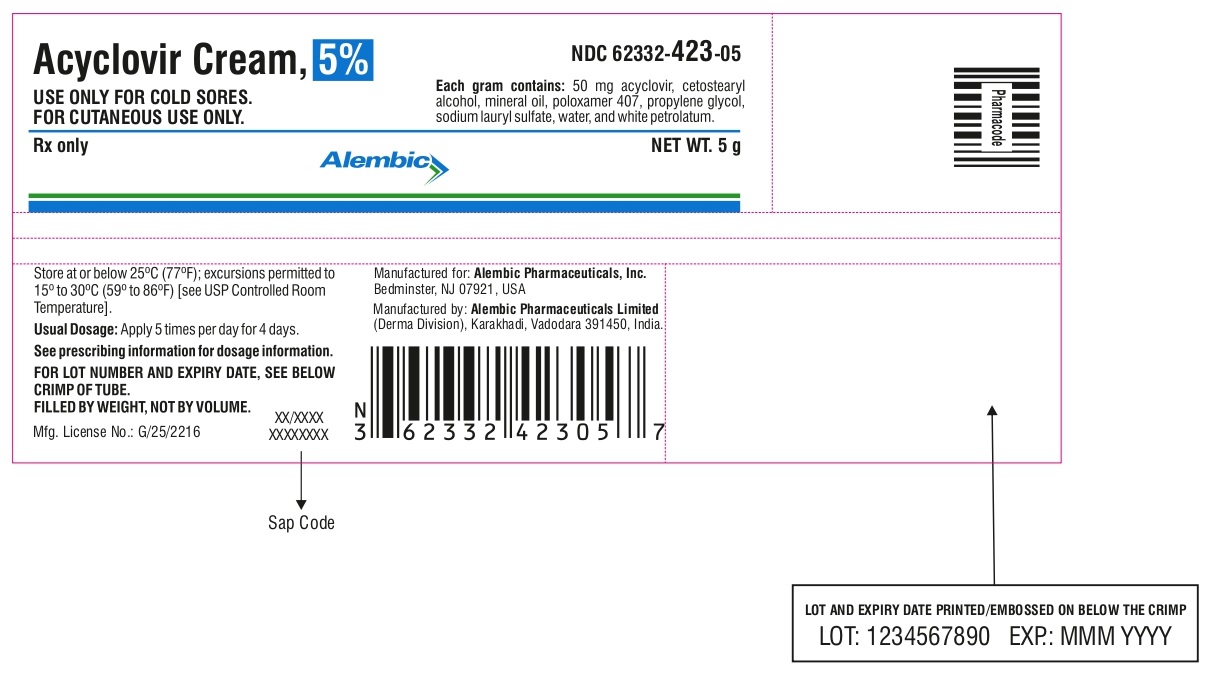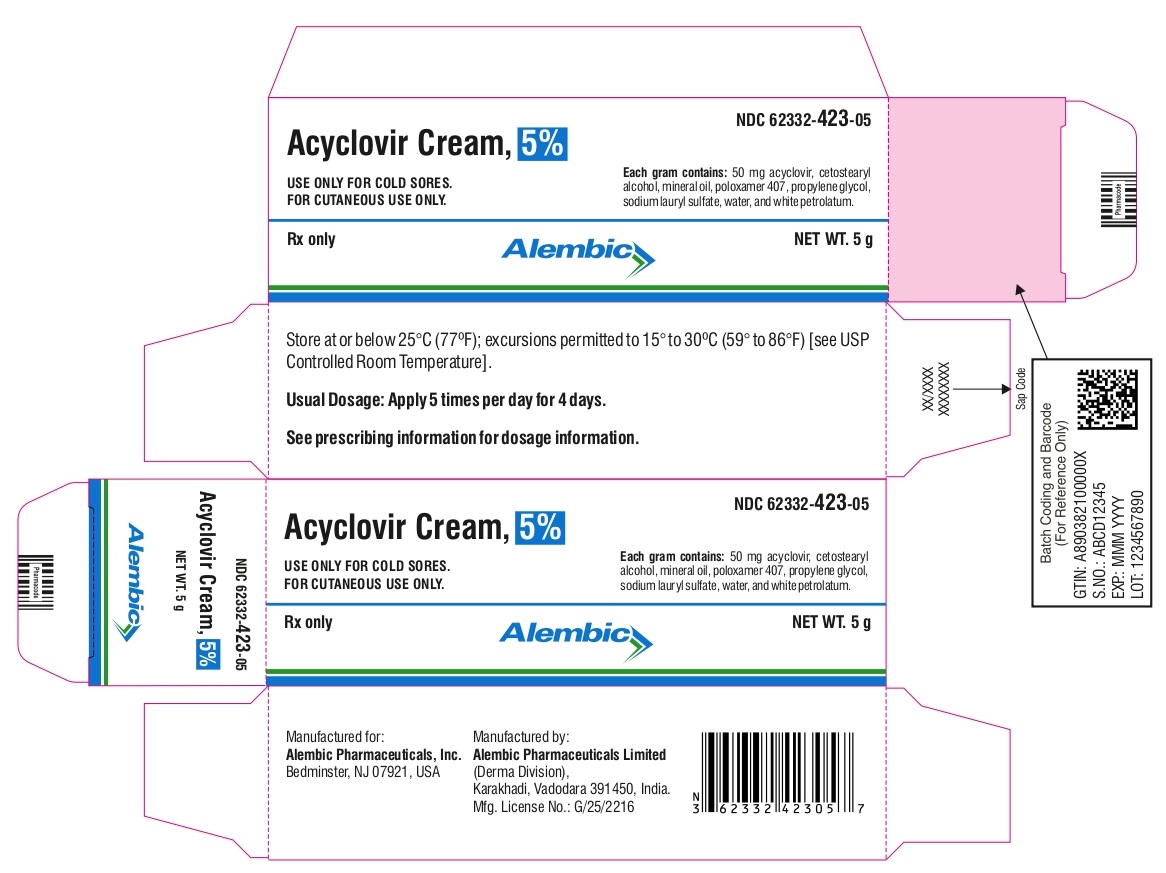Label: ACYCLOVIR cream
- NDC Code(s): 62332-423-05
- Packager: Alembic Pharmaceuticals Inc.
- Category: HUMAN PRESCRIPTION DRUG LABEL
- DEA Schedule: None
- Marketing Status: Abbreviated New Drug Application
Drug Label Information
Updated November 27, 2023
If you are a consumer or patient please visit this version.
- Download DRUG LABEL INFO: PDF XML
- Official Label (Printer Friendly)
-
HIGHLIGHTS OF PRESCRIBING INFORMATION
These highlights do not include all the information needed to use ACYCLOVIR CREAM safely and effectively. See full prescribing information for ACYCLOVIR CREAM.
ACYCLOVIR cream, for topical use
Initial U.S. Approval: 2002INDICATIONS AND USAGE
Acyclovir cream is a herpes simplex virus (HSV) deoxynucleoside analogue DNA polymerase inhibitor indicated for the treatment of recurrent herpes labialis (cold sores) in immunocompetent adults and adolescents 12 years of age and older. (1)
DOSAGE AND ADMINISTRATION
DOSAGE FORMS AND STRENGTHS
Cream, 50 mg (equivalent to 5% w/w) acyclovir. (3)
CONTRAINDICATIONS
Acyclovir cream is contraindicated in patients with known hypersensitivity to acyclovir, valacyclovir or any component of the formulation. (4)
WARNINGS AND PRECAUTIONS
ADVERSE REACTIONS
- The most common adverse reactions reported were local skin reactions at the application site. (6.1)
- Angioedema, anaphylaxis, contact dermatitis and eczema have been reported. (6.2)
To report SUSPECTED ADVERSE REACTIONS, contact Alembic Pharmaceuticals, Inc. at 1-866-210-9797 or FDA at 1-800-FDA-1088 or www.fda.gov/medwatch.
DRUG INTERACTIONS
Clinical experience has identified no interactions resulting from topical or systemic administration of other drugs concomitantly with acyclovir cream. Due to minimal systemic absorption of acyclovir cream, systemic drug interactions are unlikely. (7)
See 17 for PATIENT COUNSELING INFORMATION and FDA-approved patient labeling.
Revised: 11/2023
-
Table of Contents
FULL PRESCRIBING INFORMATION: CONTENTS*
1 INDICATIONS AND USAGE
2 DOSAGE AND ADMINISTRATION
3 DOSAGE FORMS AND STRENGTHS
4 CONTRAINDICATIONS
5 WARNINGS AND PRECAUTIONS
5.1 General
5.2 Contact Sensitization
6 ADVERSE REACTIONS
6.1 Clinical Trials Experience
6.2 Postmarketing Experience
7 DRUG INTERACTIONS
8 USE IN SPECIFIC POPULATIONS
8.1 Pregnancy
8.2 Lactation
8.4 Pediatric Use
8.5 Geriatric Use
10 OVERDOSAGE
11 DESCRIPTION
12 CLINICAL PHARMACOLOGY
12.1 Mechanism of Action
12.3 Pharmacokinetics
12.4 Microbiology
13 NONCLINICAL TOXICOLOGY
13.1 Carcinogenesis, Mutagenesis, Impairment of Fertility
14 CLINICAL STUDIES
14.1 Adult Subjects
14.2 Pediatric Subjects
16 HOW SUPPLIED/STORAGE AND HANDLING
17 PATIENT COUNSELING INFORMATION
- *
- Sections or subsections omitted from the full prescribing information are not listed.
- 1 INDICATIONS AND USAGE
-
2 DOSAGE AND ADMINISTRATION
Acyclovir cream should be applied 5 times per day for 4 days. Therapy should be initiated as early as possible following the onset of signs or symptoms of herpes labialis, i.e. during the prodrome or when lesions appear.
For adolescents 12 years of age and older, the dosage is the same as in adults.
- 3 DOSAGE FORMS AND STRENGTHS
- 4 CONTRAINDICATIONS
-
5 WARNINGS AND PRECAUTIONS
5.1 General
Acyclovir cream should only be applied on the affected external aspects of the lips and face in patients with herpes labialis. Because no data are available, application to human mucous membranes is not recommended. Acyclovir cream is intended for cutaneous use only and should not be used in the eye or inside the mouth or nose.
5.2 Contact Sensitization
Acyclovir cream has a potential for irritation and contact sensitization [see Adverse Reactions (6.1)].
The effect of acyclovir cream has not been established in immunocompromised patients.
-
6 ADVERSE REACTIONS
6.1 Clinical Trials Experience
Because clinical trials are conducted under widely varying conditions, adverse reaction rates observed in the clinical trials of a drug cannot be directly compared to rates in the clinical trials of another drug, and may not reflect the rates observed in clinical practice.
In five double-blind, placebo-controlled trials, 1124 patients were treated with acyclovir cream and 1161 with placebo (vehicle) cream. Local application site reactions were reported by 5% of patients receiving acyclovir cream and 4% of patients receiving placebo. The most common adverse reactions at the site of topical application were dry lips, desquamation, dryness of skin, cracked lips, burning skin, pruritus, flakiness of skin, and stinging on skin; each adverse reaction occurred in less than 1% of patients receiving acyclovir cream and placebo. Three patients on acyclovir cream and one patient on placebo discontinued treatment due to an adverse event.
An additional study, enrolling 22 healthy adults, was conducted to evaluate the dermal tolerance of acyclovir cream compared with vehicle using single occluded and semi-occluded patch testing methodology. Both acyclovir cream and placebo showed a high and cumulative irritation potential. Another study, enrolling 251 healthy adults, was conducted to evaluate the contact sensitization potential of acyclovir cream using repeat insult patch testing methodology. Of 202 evaluable subjects, possible cutaneous sensitization reactions were observed in the same 4 (2%) subjects with both acyclovir cream and placebo, and these reactions to both acyclovir cream and placebo were confirmed in 3 subjects upon rechallenge. The sensitizing ingredient(s) has not been identified.
The safety profile in patients 12 to 17 years of age was similar to that observed in adults.
6.2 Postmarketing Experience
In addition to adverse events reported from clinical trials, the following events have been identified during postapproval use of acyclovir cream. Because they are reported voluntarily from a population of unknown size, estimates of frequency cannot be made. These events have been chosen for inclusion due to a combination of their seriousness, frequency of reporting, or potential causal connection to acyclovir cream.
General: Angioedema, anaphylaxis.
Skin: Contact dermatitis, eczema.
- 7 DRUG INTERACTIONS
-
8 USE IN SPECIFIC POPULATIONS
8.1 Pregnancy
Acyclovir is minimally absorbed systemically following topical route of administration, and maternal use is not expected to result in fetal exposure to the acyclovir cream [see Clinical Pharmacology (12.3)]. Experience with topical acyclovir use in pregnant women over several decades, based on published literature including observational studies, has not identified a drug-associated risk of major birth defects, miscarriage or adverse maternal or fetal outcomes. Animal reproduction studies with systemic exposure of acyclovir have been conducted. Refer to acyclovir prescribing information for additional details.
The estimated background risk of major birth defects and miscarriage for the indicated population is unknown. All pregnancies have a background risk of birth defect, loss, or other adverse outcomes. In the U.S. general population, the estimated background risk of major birth defects and miscarriage in clinically recognized pregnancies is 2% to 4% and 15% to 20%, respectively.
8.2 Lactation
Acyclovir is minimally absorbed systemically following topical route of administration, and breastfeeding is not expected to result in exposure of the child to acyclovir cream [see Clinical Pharmacology (12.3)]. There are no data on the effects of acyclovir cream on the breastfed infant or on milk production. The developmental and health benefits of breastfeeding should be considered along with the mother's clinical need for acyclovir cream and any potential adverse effects on the breastfed child from acyclovir cream or from the underlying maternal condition.
8.4 Pediatric Use
An open-label, uncontrolled trial with acyclovir cream was conducted in 113 patients aged 12 to 17 years with recurrent herpes labialis. In this trial, therapy was applied using the same dosing regimen as in adults and subjects were followed for adverse events. The safety profile was similar to that observed in adults. Safety and effectiveness in pediatric patients less than 12 years of age have not been established.
8.5 Geriatric Use
Clinical studies of acyclovir cream did not include sufficient numbers of subjects aged 65 and over to determine whether they respond differently from younger subjects. Other reported clinical experience has not identified differences in responses between the elderly and younger patients. Systemic absorption of acyclovir after topical administration is minimal [see Clinical Pharmacology (12.3)].
-
10 OVERDOSAGE
Overdosage by topical application of acyclovir cream is unlikely because of minimal systemic exposure [see Clinical Pharmacology (12.3)]. There is no information available for overdose.
-
11 DESCRIPTION
Acyclovir cream is the proposed generic name for acyclovir, a synthetic deoxynucleoside analogue active against herpes viruses. Acyclovir cream, 5% is a formulation for topical administration.
The chemical name of acyclovir is 2-amino-1,9-dihydro-9-[(2-hydroxyethoxy) methyl]-6H-purin-6-one; it has the following structural formula:
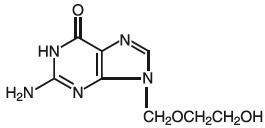
Acyclovir is a white, crystalline powder with the molecular formula C8H11N5O3 and a molecular weight of 225. The maximum solubility in water at 37°C is 2.5 mg/mL. The pKa's of acyclovir are 2.27 and 9.25.
Each gram of acyclovir cream contains 50 mg (equivalent to 5% w/w) of acyclovir and the following inactive ingredients: cetostearyl alcohol, mineral oil, poloxamer 407, propylene glycol, sodium lauryl sulfate, water and white petrolatum.
-
12 CLINICAL PHARMACOLOGY
12.1 Mechanism of Action
Acyclovir is an antiviral drug active against α-herpes viruses [see Microbiology (12.4)].
12.3 Pharmacokinetics
A clinical pharmacology study was performed with acyclovir cream in adult volunteers to evaluate the percutaneous absorption of acyclovir. In this study, which included 6 male volunteers, the cream was applied to an area of 710 cm2 on the backs of the volunteers 5 times daily at intervals of 2 hours for a total of 4 days. The weight of cream applied and urinary excretion of acyclovir were measured daily. Plasma concentration of acyclovir was assayed 1 hour after the final application. The average daily urinary excretion of acyclovir was approximately 0.04% of the daily applied dose. Plasma acyclovir concentrations were below the limit of detection (0.01 μM) in 5 subjects and barely detectable (0.014 μM) in 1 subject. Systemic absorption of acyclovir from acyclovir cream is minimal in adults.
The systemic absorption of acyclovir following topical application of cream has not been evaluated in patients <18 years of age.
12.4 Microbiology
Mechanism of Action: Acyclovir is a synthetic purine deoxynucleoside analogue with cell culture and in vivo inhibitory activity against HSV types 1 (HSV-1) and 2 (HSV-2) DNA polymerases. It inhibits HSV-1 and HSV-2 replication in cell culture and in vivo.
The inhibitory activity of acyclovir is selective due to its affinity for the enzyme thymidine kinase (TK) encoded by HSV. This viral enzyme converts acyclovir into acyclovir monophosphate, a deoxynucleotide analogue. The monophosphate is further converted into diphosphate by cellular guanylate kinase and into triphosphate by a number of cellular enzymes. In biochemical assays, acyclovir triphosphate inhibits replication of α-herpes viral DNA. This inhibition is accomplished in 3 ways: 1) competitive inhibition of viral DNA polymerase, 2) incorporation into and termination of the growing viral DNA chain, and 3) inactivation of the viral DNA polymerase.
Antiviral Activity
The quantitative relationship between the susceptibility of herpes viruses to antivirals in cell culture and the clinical response to therapy has not been established in humans, and virus sensitivity testing has not been standardized. Sensitivity testing results, expressed as the concentration of drug required to inhibit by 50% the growth of virus in cell culture (EC50 value), vary greatly depending upon a number of factors. Using plaque-reduction assays on Vero cells, the EC50 values of acyclovir against herpes simplex virus isolates range from 0.09 to 59.9 μM (0.02 to 13.5 mcg/mL) for HSV-1 and from 0.04 to 44.0 μM (0.01 to 9.9 mcg/mL) for HSV-2.
Resistance
In Cell Culture
Acyclovir-resistant HSV-1 and HSV-2 strains were isolated in cell culture. Acyclovir-resistant HSV resulted from mutations in the viral thymidine kinase (TK; pUL23) and DNA polymerase (POL; pUL30) genes. Frameshifts were commonly isolated and result in premature truncation of the HSV TK product with consequent decreased susceptibility to acyclovir. Mutations in the viral TK gene may lead to complete loss of TK activity (TK negative), reduced levels of TK activity (TK partial), or alteration in the ability of viral TK to phosphorylate the drug without an equivalent loss in the ability to phosphorylate thymidine (TK altered). In cell culture the following resistance-associated substitutions in TK of HSV-1 and HSV-2 were observed (Table 1).
Table 1: Summary of Acyclovir (ACV) Resistance-associated Amino Acid Substitutions in Cell Culture HSV-1
TK
P5A, H7Q, L50V, G56V, G59A, G61A, K62N, T63A, E83K, P84S, D116N, P131S, R163H, A167V, P173L, Q185R, R216S, R220H, T245M, R281stop, T287M, M322K
HSV-2
TK
L69P, C172R, T288M
HSV-1
POL
D368A, Y557S, E597D, V621S, L702H, N815S, V817M, G841C
HSV-2
POL
-
Clinical HSV-1 and HSV-2 isolates obtained from patients who failed treatment for their α-herpesvirus infections were evaluated for genotypic changes in the TK and POL genes and for phenotypic resistance to acyclovir (Table 2). HSV isolates with frameshift mutations and resistance-associated substitutions in TK and POL were identified. The listing of substitutions in HSV TK and POL leading to decreased susceptibility to acyclovir is not all inclusive and additional changes will likely be identified in HSV variants isolated from patients who fail acyclovir-containing regimens. The possibility of viral resistance to acyclovir should be considered in patients who fail to respond or experience recurrent viral shedding during therapy.
Table 2: Summary of ACV Resistance-associated Amino Acid Substitutions Observed in Treated Patients HSV-1
TK
G6C, R32H, R41H, R51W, Y53C/D/H, Y53stop, D55N, G56D/S, P57H, H58/N/R/Y, G59R, G61A, K62N, T63I, Q67stop, S74stop, Y80N, E83K, P84L, Y87H, W88R, R89Q/W, E95stop, T103P, Q104H, Q104stop, H105P, D116N, M121L/R, S123R, Q125H, M128L, G129D, I143V, A156V, D162A/H/N, R163G/H, L170P, Y172C, P173L, A174P, A175V, R176Q/W, R176stop, L178R, S181N, V187M, A189V, V192A, G200C/D/S, T201P, V204G, A207P, L208F/H, R216C/H, R220C/H, R221H, R222C/H, L227F, T245M/P, L249P, Q250Stop, C251G, R256W, E257K, Q261R, T287M, L288Stop, L291P/R, L297S, L315S, L327R, C336Y, Q342Stop, T354P, L364P, A365T
HSV-2
TK
R34C, G39E, R51W, Y53N, G59P, G61W, S66P, A72S, D78N, P85S, A94V, N100H, I101S, Q105P, T131P, D137stop, F140L, L158P, S169P, R177W, S182N, M183I, V192M, G201D, R217H, R221C/H, Q222stop, R223H, Y239stop, R271V, P272S, D273R, T287M, C337Y
HSV-1
POL
K532T, Q570R, L583V, A605V, A657T, D672N, V715G, A719T/V, S724N, F733C, E771Q, S775N, L778M, E798K, V813M, N815S, G841S, I890M, G901V, V958L H1228D
HSV-2
POL
E250Q, D307N, K533E, A606V, C625R, R628C, E678G, A724V, S725G, S729N, I731F, Q732R, M789K/T, V818A, N820S, Y823C, Q829R, T843A, M910T, D912N/V, A915V, F923L, T934A, R964H
Note: Additional substitutions to acyclovir resistance may exist.
Cross-resistance
Cross-resistance has been observed among HSV isolates carrying frameshift mutations and resistance-associated substitutions, which confer reduced susceptibility to penciclovir (PCV), famciclovir (FCV), and foscarnet (FOS) [Table 3].
Table 3: Summary of Amino Acid Substitutions Conferring Cross-Resistance to PCV, FCV or FOS Cross-resistant to PCV/FCV
HSV-1 TK
G6C, R32H, R51W, Y53C/H, H58N, G61A, S74Stop, E83K, P84L, T103P, Q104Stop, D116N, M121R, I143V, R163H, L170P, Y172C, A174P, R176Q/W, Q185R, A189V, G200D, L208H, R216C, R220H, R222C/H, T245M, Q250Stop, R256W, R281Stop, T287M, L315S, M322K, C336Y
Cross-resistant to PCV/FCV
HSV-1 POL
A657T, D672N, V715G, A719V, S724N, E798K, N815S, G841S
Cross-resistant to PCV/FCV
HSV-2 TK
G39E, R51W, Y53N, R177W, R221H, T288M
Cross-resistant to PCV/FCV
HSV-2 POL
K533E, A606V, C625R, R628C, S729N, Q732R, M789K/T, V818A, N820S, F923L, T934A
Cross-resistant to FOS
HSV-1 POL
D368A, A605V, D672N, L702H, V715G, A719T/V, S724N, L778M, E798K, V813M, N815S, V817M, G841C/S, I890M,
Cross-resistant to FOS
HSV-2 POL
K533E, A606V, C625R, R628C, A724V, S725G, S729N, I731F, Q732R, M789K/T, V818A, Y823C, D912V, F923L, T934A, R964H
-
13 NONCLINICAL TOXICOLOGY
13.1 Carcinogenesis, Mutagenesis, Impairment of Fertility
Systemic exposure following topical administration of acyclovir is minimal. Dermal carcinogenicity studies were not conducted. Results from the studies of carcinogenesis, mutagenesis and fertility are not included in the full prescribing information for acyclovir cream due to the minimal exposures of acyclovir that result from dermal application. Information on these studies is available in the full prescribing information for acyclovir capsules, tablets, and suspension and acyclovir for injection.
-
14 CLINICAL STUDIES
14.1 Adult Subjects
Acyclovir cream was evaluated in two double-blind, randomized, placebo (vehicle)-controlled trials for the treatment of recurrent herpes labialis. The average patient had five episodes of herpes labialis in the previous 12 months. In the first trial, the median age of subjects was 37 years (range 18 to 81 years), 74% were female, and 94% were Caucasian. In the second trial, median age of subjects was 38 years (range 18 to 87 years), 73% were female, and 94% were Caucasian. Subjects were instructed to initiate treatment within 1 hour of noticing signs or symptoms and continue treatment for 4 days, with application of study medication 5 times per day. In both studies, the mean duration of the recurrent herpes labialis episode was approximately one-half day shorter in the subjects treated with acyclovir cream (n = 682) compared with subjects treated with placebo (n = 703) for approximately 4.5 days versus 5 days, respectively. No significant difference was observed between subjects receiving acyclovir cream or placebo in the prevention of progression of cold sore lesions.
14.2 Pediatric Subjects
An open-label, uncontrolled trial with acyclovir cream was conducted in 113 patients aged 12 to 17 years with recurrent herpes labialis. In this trial, therapy was applied using the same dosing regimen as in adults and subjects were followed for adverse events. The safety profile was similar to that observed in adults.
- 16 HOW SUPPLIED/STORAGE AND HANDLING
-
17 PATIENT COUNSELING INFORMATION
Advise the patient to read the FDA-approved patient labeling (Patient Information).
General
Patients should be informed that acyclovir cream is a prescription topical cream for the treatment of cold sores (recurrent herpes labialis) that occur on the face and lips. Acyclovir cream is not a cure for cold sores. Patients should be instructed that acyclovir cream is intended for cutaneous use only for herpes labialis of the lips and around the mouth. Patients should be advised that acyclovir cream should not be used in the eye, inside the mouth or nose, or on the genitals. Patients should be instructed to avoid applying other topical products to the affected area while using acyclovir cream.
Do not use if you are allergic to acyclovir cream or any of the ingredients in acyclovir cream. Before you use acyclovir cream, tell your doctor if you are pregnant, planning to become pregnant, or are breast-feeding.
Instructions for Use
Treatment should be initiated at the earliest sign or symptom of recurrence. Instruct patients to wash hands prior to application and ensure the face and/or lips are clean and dry. Advise patients to apply acyclovir cream topically 5 times per day for 4 days. Instruct patients to topically apply a quantity of acyclovir cream sufficient to cover the affected area, including the outer margin. Advise patients to avoid unnecessary rubbing of the affected area to avoid aggravating or transferring the infection. Instruct patients to wash their hands with soap and water after using acyclovir cream. Keep out of reach of children.
Possible Side Effects
Common skin-related side effects that occurred when acyclovir cream was applied include application site reactions. Acyclovir cream has the potential for irritation and contact sensitization.
Manufactured for:
Alembic Pharmaceuticals, Inc.
Bedminster, NJ 07921, USA
Manufactured by:
Alembic Pharmaceuticals Limited
(Derma Division),
Karakhadi, Vadodara 391450, India.
Mfg. License No.: G/25/2216
Manufactured by:
Encube Ethicals Pvt. Ltd.,
Madkaim, Ponda, Goa, India – 403404
Mfg. License No: 361
-
PATIENT PACKAGE INSERT
PATIENT INFORMATION
Acyclovir (ay-SYE-kloe-vir)
Cream
Important information: Acyclovir cream is for use on cold sores on the lips and around the mouth only. Acyclovir cream should not be used in your eyes, mouth, nose, or on your genitals.
What is acyclovir cream?
- Acyclovir cream is a prescription medicine used to treat cold sores (herpes labialis) that are recurring in adults and children 12 years of age and older, and who have normal immune systems.
- Acyclovir cream is not a cure for cold sores.
Do not use acyclovir cream if you are allergic to acyclovir, valacyclovir, or any of the ingredients in acyclovir cream. See the end of this leaflet for a complete list of ingredients in acyclovir cream.
What should I tell my healthcare provider before using acyclovir cream?
Before using acyclovir cream, tell your healthcare provider about all of your medical conditions, including if you:
- become sick very easily (have a weak immune system).
- are pregnant or plan to become pregnant. It is not known if acyclovir cream will harm your unborn baby.
- are breastfeeding or plan to breastfeed. It is not known if acyclovir cream passes into your breast milk. Talk to your healthcare provider about the best way to feed your baby if you use acyclovir cream.
How should I use acyclovir cream?
- Use acyclovir cream exactly as your healthcare provider tells you to use it.
- Use acyclovir cream as soon as you have the first symptoms of a cold sore such as itching, redness, burning or tingling, or when the cold sore appears.
- Wash your hands with soap and water before and after applying acyclovir cream.
- The affected area should be clean and dry before applying acyclovir cream.
- Apply acyclovir cream to the affected area 5 times each day for 4 days, including the outer edge.
- You should not apply other skin products to the affected area during treatment with acyclovir cream.
- Avoid unnecessary rubbing of the cold sore because this may cause the cold sore to spread to other areas around your mouth or make your cold sore worse.
What are the possible side effects of acyclovir cream?
The most common side effects of acyclovir cream are skin reactions at the treatment site and may include: dry or cracked lips, peeling, flaking or dryness of the skin, a burning or stinging feeling, and itching.
These are not all the possible side effects of acyclovir cream.
Call your doctor for medical advice about side effects. You may report side effects to FDA at 1-800-FDA-1088.
How should I store acyclovir cream?
- Store acyclovir cream at room temperature between 68° to 77°F (20° to 25°C).
General information about the safe and effective use of acyclovir cream.
Medicines are sometimes prescribed for purposes other than those listed in a Patient Information leaflet. Do not use acyclovir cream for a condition for which it was not prescribed. Do not give acyclovir cream to other people, even if they have the same symptoms you have. It may harm them. You can ask your pharmacist or healthcare provider for information about acyclovir cream that is written for health professionals.
What are the ingredients in acyclovir cream?
Active ingredient: acyclovir
Inactive ingredients: cetostearyl alcohol, mineral oil, poloxamer 407, propylene glycol, sodium lauryl sulfate, water, and white petrolatum
Manufactured for:
Alembic Pharmaceuticals, Inc.
Bedminster, NJ 07921, USA
Manufactured by:
Alembic Pharmaceuticals Limited
(Derma Division),
Karakhadi, Vadodara 391450, India.
Mfg. License No.: G/25/2216
For more information, call 1-866-210-9797.
Manufactured by:
Encube Ethicals Pvt. Ltd.,
Madkaim, Ponda, Goa, India – 403404
Mfg. License No: 361
This Patient Information has been approved by the U.S. Food and Drug Administration. Revised: 11/2023
-
PACKAGE LABEL.PRINCIPAL DISPLAY PANEL
PRINCIPAL DISPLAY PANEL - 5g Tube Carton
ACYCLOVIR CREAM 5%
NDC 62332-423-05
Net Wt. 5 g
Each gram contains:
50 mg acyclovir, cetostearyl alcohol, mineral oil, poloxamer 407, propylene glycol, sodium lauryl sulfate, water and white petrolatum.
USE ONLY FOR COLD SORES.
FOR CUTANEOUS USE ONLY.
Rx only
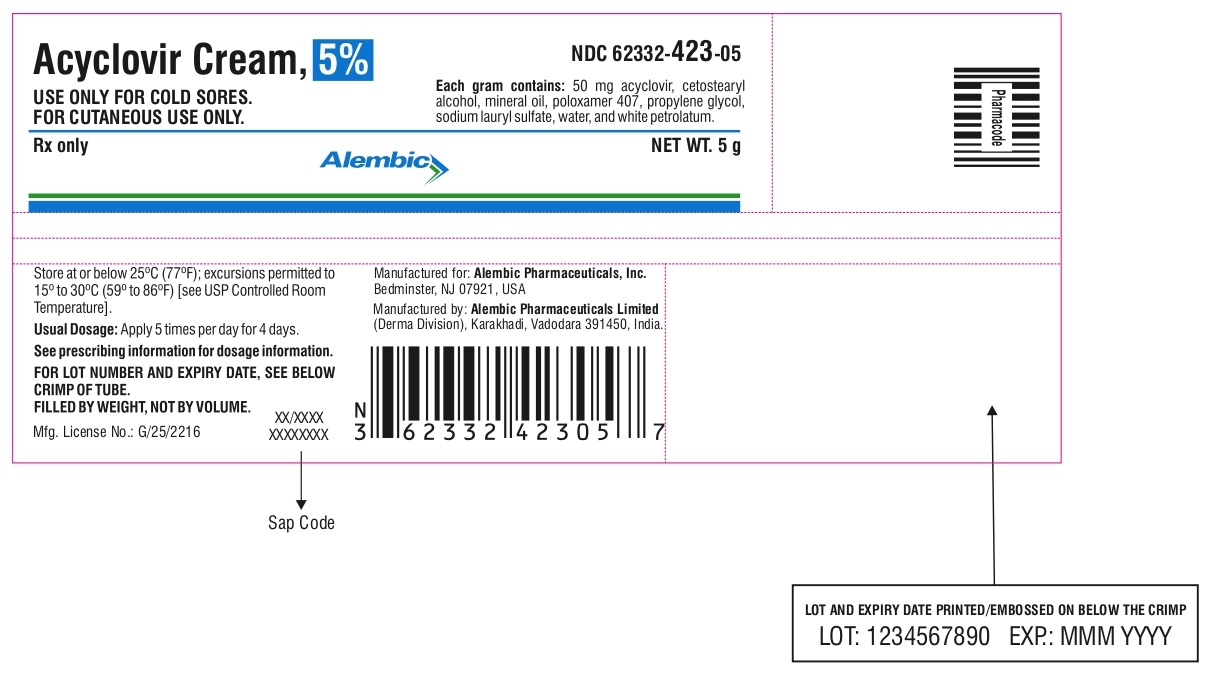
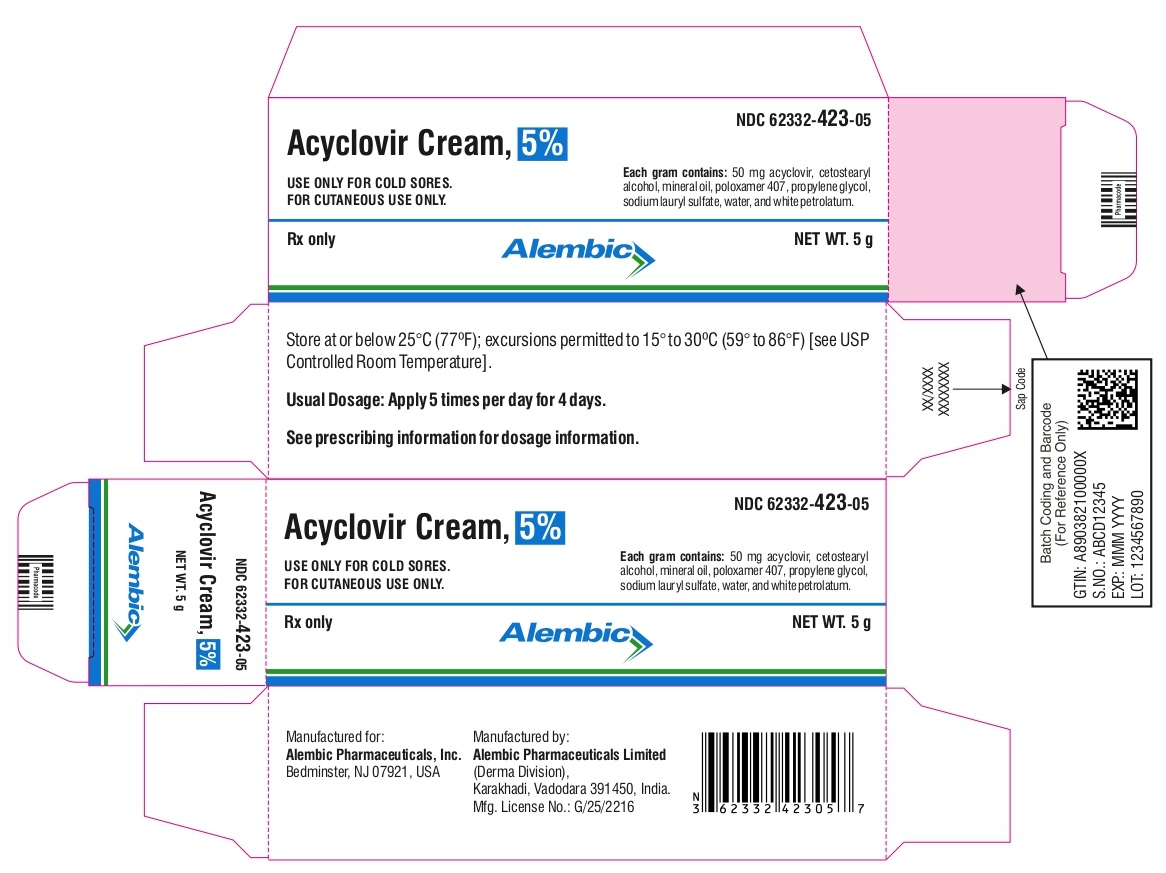
-
INGREDIENTS AND APPEARANCE
ACYCLOVIR
acyclovir creamProduct Information Product Type HUMAN PRESCRIPTION DRUG Item Code (Source) NDC:62332-423 Route of Administration TOPICAL Active Ingredient/Active Moiety Ingredient Name Basis of Strength Strength ACYCLOVIR (UNII: X4HES1O11F) (ACYCLOVIR - UNII:X4HES1O11F) ACYCLOVIR 50 mg in 1 g Inactive Ingredients Ingredient Name Strength CETOSTEARYL ALCOHOL (UNII: 2DMT128M1S) MINERAL OIL (UNII: T5L8T28FGP) POLOXAMER 407 (UNII: TUF2IVW3M2) PROPYLENE GLYCOL (UNII: 6DC9Q167V3) SODIUM LAURYL SULFATE (UNII: 368GB5141J) WATER (UNII: 059QF0KO0R) PETROLATUM (UNII: 4T6H12BN9U) Packaging # Item Code Package Description Marketing Start Date Marketing End Date 1 NDC:62332-423-05 1 in 1 CARTON 11/27/2023 1 5 g in 1 TUBE; Type 0: Not a Combination Product Marketing Information Marketing Category Application Number or Monograph Citation Marketing Start Date Marketing End Date ANDA ANDA212361 11/27/2023 Labeler - Alembic Pharmaceuticals Inc. (079288842) Registrant - Alembic Pharmaceuticals Limited (650574663) Establishment Name Address ID/FEI Business Operations Alembic Pharmaceuticals Limited 871411532 MANUFACTURE(62332-423) , ANALYSIS(62332-423) Establishment Name Address ID/FEI Business Operations Encube Ethicals Pvt. Ltd. 725076298 MANUFACTURE(62332-423)

